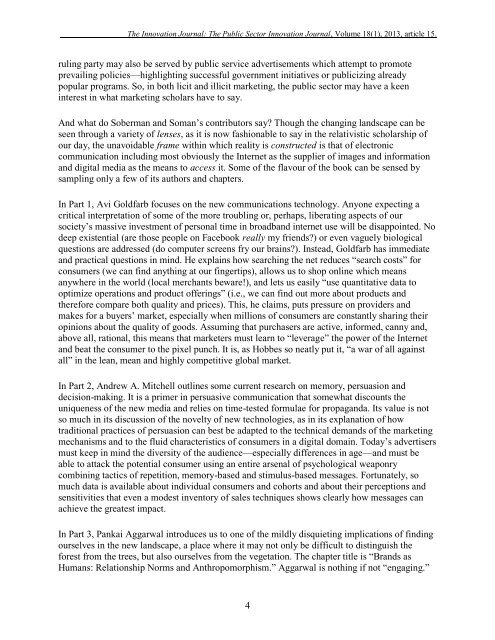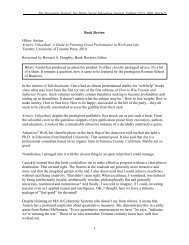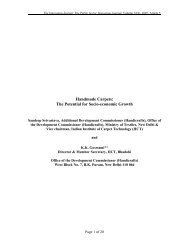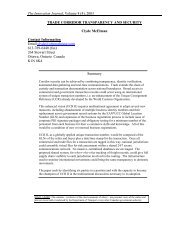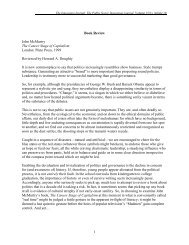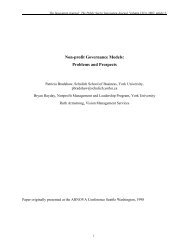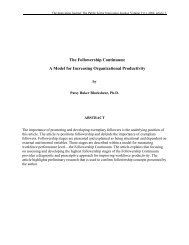What Marketing Managers Need to Navigate the New Environment
What Marketing Managers Need to Navigate the New Environment
What Marketing Managers Need to Navigate the New Environment
You also want an ePaper? Increase the reach of your titles
YUMPU automatically turns print PDFs into web optimized ePapers that Google loves.
The Innovation Journal: The Public Sec<strong>to</strong>r Innovation Journal, Volume 18(1), 2013, article 15.<br />
ruling party may also be served by public service advertisements which attempt <strong>to</strong> promote<br />
prevailing policies—highlighting successful government initiatives or publicizing already<br />
popular programs. So, in both licit and illicit marketing, <strong>the</strong> public sec<strong>to</strong>r may have a keen<br />
interest in what marketing scholars have <strong>to</strong> say.<br />
And what do Soberman and Soman’s contribu<strong>to</strong>rs say? Though <strong>the</strong> changing landscape can be<br />
seen through a variety of lenses, as it is now fashionable <strong>to</strong> say in <strong>the</strong> relativistic scholarship of<br />
our day, <strong>the</strong> unavoidable frame within which reality is constructed is that of electronic<br />
communication including most obviously <strong>the</strong> Internet as <strong>the</strong> supplier of images and information<br />
and digital media as <strong>the</strong> means <strong>to</strong> access it. Some of <strong>the</strong> flavour of <strong>the</strong> book can be sensed by<br />
sampling only a few of its authors and chapters.<br />
In Part 1, Avi Goldfarb focuses on <strong>the</strong> new communications technology. Anyone expecting a<br />
critical interpretation of some of <strong>the</strong> more troubling or, perhaps, liberating aspects of our<br />
society’s massive investment of personal time in broadband internet use will be disappointed. No<br />
deep existential (are those people on Facebook really my friends?) or even vaguely biological<br />
questions are addressed (do computer screens fry our brains?). Instead, Goldfarb has immediate<br />
and practical questions in mind. He explains how searching <strong>the</strong> net reduces “search costs” for<br />
consumers (we can find anything at our fingertips), allows us <strong>to</strong> shop online which means<br />
anywhere in <strong>the</strong> world (local merchants beware!), and lets us easily “use quantitative data <strong>to</strong><br />
optimize operations and product offerings” (i.e., we can find out more about products and<br />
<strong>the</strong>refore compare both quality and prices). This, he claims, puts pressure on providers and<br />
makes for a buyers’ market, especially when millions of consumers are constantly sharing <strong>the</strong>ir<br />
opinions about <strong>the</strong> quality of goods. Assuming that purchasers are active, informed, canny and,<br />
above all, rational, this means that marketers must learn <strong>to</strong> “leverage” <strong>the</strong> power of <strong>the</strong> Internet<br />
and beat <strong>the</strong> consumer <strong>to</strong> <strong>the</strong> pixel punch. It is, as Hobbes so neatly put it, “a war of all against<br />
all” in <strong>the</strong> lean, mean and highly competitive global market.<br />
In Part 2, Andrew A. Mitchell outlines some current research on memory, persuasion and<br />
decision-making. It is a primer in persuasive communication that somewhat discounts <strong>the</strong><br />
uniqueness of <strong>the</strong> new media and relies on time-tested formulae for propaganda. Its value is not<br />
so much in its discussion of <strong>the</strong> novelty of new technologies, as in its explanation of how<br />
traditional practices of persuasion can best be adapted <strong>to</strong> <strong>the</strong> technical demands of <strong>the</strong> marketing<br />
mechanisms and <strong>to</strong> <strong>the</strong> fluid characteristics of consumers in a digital domain. Today’s advertisers<br />
must keep in mind <strong>the</strong> diversity of <strong>the</strong> audience—especially differences in age—and must be<br />
able <strong>to</strong> attack <strong>the</strong> potential consumer using an entire arsenal of psychological weaponry<br />
combining tactics of repetition, memory-based and stimulus-based messages. Fortunately, so<br />
much data is available about individual consumers and cohorts and about <strong>the</strong>ir perceptions and<br />
sensitivities that even a modest inven<strong>to</strong>ry of sales techniques shows clearly how messages can<br />
achieve <strong>the</strong> greatest impact.<br />
In Part 3, Pankai Aggarwal introduces us <strong>to</strong> one of <strong>the</strong> mildly disquieting implications of finding<br />
ourselves in <strong>the</strong> new landscape, a place where it may not only be difficult <strong>to</strong> distinguish <strong>the</strong><br />
forest from <strong>the</strong> trees, but also ourselves from <strong>the</strong> vegetation. The chapter title is “Brands as<br />
Humans: Relationship Norms and Anthropomorphism.” Aggarwal is nothing if not “engaging.”<br />
4


